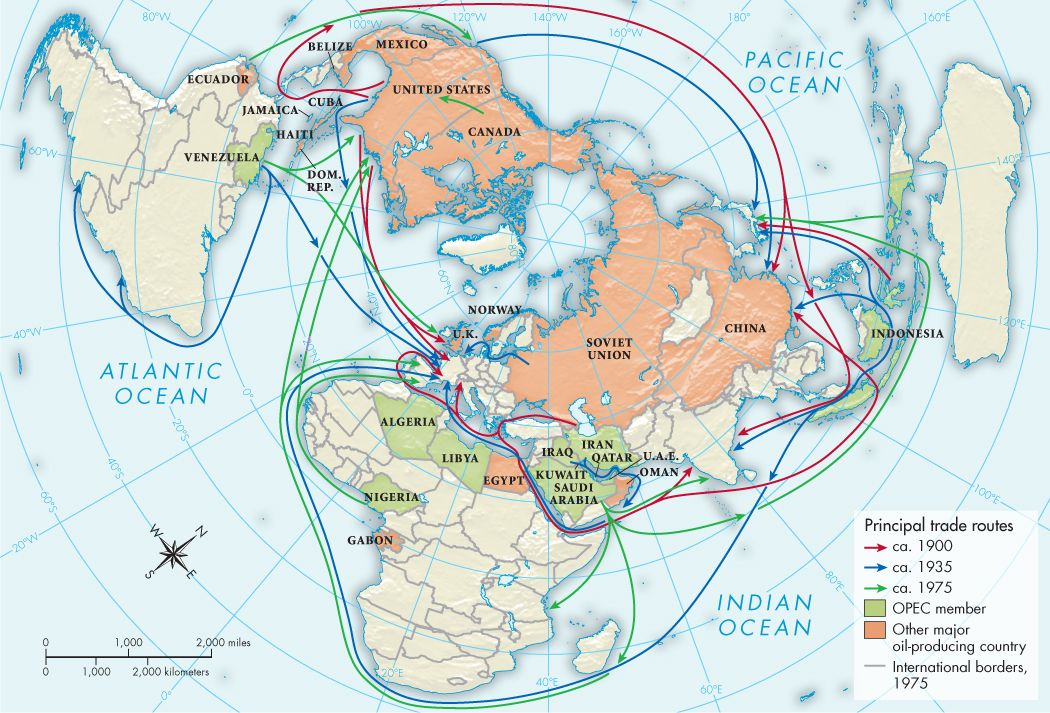Global Trade: Oil
Oil in its crude form is found as a liquid hydrocarbon located in certain rocks below the earth’s crust. Although it is found throughout the world, the Persian Gulf and Caspian Sea areas contain about three-quarters of the world’s proven reserves. The uses of crude oil are limited, but it may be refined into valuable products such as kerosene, gasoline, and fuel oil.
Oil has been used throughout history, although it did not become a worldwide commodity until the nineteenth century. In antiquity the Sumerians and Babylonians mixed evaporated oil from tar pits with sand to make asphalt for waterproofing ships and paving roads. Islamic societies in the Middle East used small quantities of oil for lighting, although cooking fires were probably the main source of light.
In Europe lamp oil — from animal fats and plants — was a luxury. The nineteenth century brought revolutionary changes in lighting, and by the 1840s manufacturers in coal-rich Europe were distilling coal into crude oil and gas for use in lighting. North America followed suit. Thus when E. L. Drake drilled the first successful American oil well in Pennsylvania in 1859, a growing demand for lamp oil already existed. The production of kerosene took off as consumers accepted the bright, clean-burning, and relatively inexpensive oil for use in their lamps.
After the late 1860s the United States exported two-thirds of its kerosene, first in wooden barrels, then in large tin cans, and finally in tankers for bulk distribution. The leading producer was John D. Rockefeller’s Standard Oil, which held a monopoly on kerosene until the U.S. government broke the corporation into separate companies in 1911. Most kerosene went to Europe at first, but other markets grew rapidly. In the 1870s the Baku region on the Caspian Sea introduced drilling and created a Russian refining industry. Russian capitalists fought well-publicized “oil wars” with Standard Oil for world kerosene markets.

MAP 32.1 The Oil Trade, ca. 1900–1975
International differences were significant. In the United States and western Europe kerosene appealed especially to farmers and urban working people, who had previously lacked decent lighting. The affluent urban classes generally continued to use coal-distilled gas until the 1880s, when electricity began to replace gas. In China peasants rejected bulk distribution and insisted on kerosene in tin cans, recycling them into valuable all-purpose containers. Russia pioneered in using oil as fuel, as the refining of heavy Baku crude yielded abundant thick “leftovers” — an excellent power source for riverboats, railroads, and factories.
During the twentieth century oil became a major fuel source as kerosene production declined. Until 1941 the explosive growth of automobiles in the United States was easily outpaced by the development of domestic oil fields, enabling the United States to sell one-third of all the oil consumed beyond its borders. In oil-poor Europe (Russia excepted), fuel oil loomed large as a strategic material. After 1919 the British government took control of the two oil companies in Iran and Iraq to guarantee supplies for Britain’s military and industrial needs. Germany distilled coal into synthetic gasoline, and Hitler relentlessly pushed production of this very expensive alternative to free his war machine from dependence on foreign oil.
The international oil trade shifted dramatically after 1945. The United States, previously producing half the world’s oil, became the world’s largest importer. The Middle East, producing very modestly in the 1920s and 1930s, became the world’s leading exporter. At the same time, western Europe and Japan shifted from coal to oil to drive their factories and fuel their automobiles. Nevertheless, the American and British oil companies in the Middle East expanded output so rapidly — sixteen times between 1948 and 1972 — that the inflation-adjusted price for Middle Eastern oil fell substantially in these years.
Increasingly dissatisfied with their share of the profits, the main exporting countries — Iran, Iraq, Kuwait, Saudi Arabia, and Venezuela — created the Organization of Petroleum Exporting Countries (OPEC) in 1960 to gain control of their oil resources. In 1973, during the Arab-Israeli war, OPEC engineered a fourfold price increase with enormous global consequences. The exporting states also nationalized their oil industries, reducing foreign companies to simple buyers and transporters. The oil exporters used their financial windfalls to improve health and living standards somewhat, but vast sums went for lavish spending by the elite and for overly ambitious development projects. Above all, the money went for expensive military hardware from the industrialized countries, which increased tensions and prolonged the terrible war between Iraq and Iran in the 1980s (see “Revolution and War in Iran and Iraq”).
A price collapse followed the upward price revolution of the 1970s. In the 1980s and early 1990s conservation, greater efficiency, recession, environmental concerns, and significant new oil discoveries outside the Middle East eliminated much of the inflation-adjusted price increases of the 1970s. By 2002 some argued that oil was really “just another commodity.” The outbreak of the Iraq War in 2003, however — followed by natural disasters such as Hurricane Katrina; instability in Nigeria, Venezuela, and other major oil-producing countries; and skyrocketing demand for oil by China and India — sent oil to nearly $150 per barrel by 2008, creating another global energy crisis.
